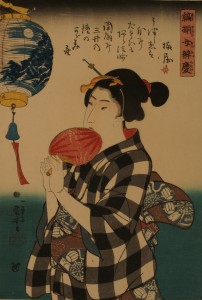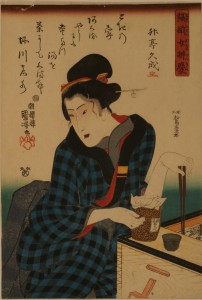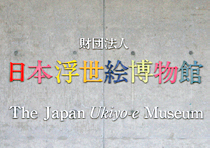縞揃女弁慶と武者 / 世界文化遺産の富士山の世界 Ⅱ
縞揃女弁慶と武者
The Metaphorical BENKEI and the Samurai Warriors
歌川国芳「縞揃女弁慶」は全十枚の弁慶の生涯を題材に描いた見立絵のシリーズです。いかめしい弁慶が弁慶縞のしゃれた衣装の美人となり、その頃流行の江戸前寿司を食べたりしています。そして同じ画題の國芳の武者絵や三代目歌川豊国の団扇絵の傑作を多数展示します。天保改革の規制の暗闇で花開いた庶民の文化をご覧ください。
Kuniyoshi’s series, Shimazoroi Onna Benkei, focuses on the life of Benkei (a historical Male figure) metaphorically through pictures of women. Other prints by Kuniyoshi, of samurai , are also exhibited. These series brought to light the previously forbidden culture of the Tenpo period (1830-1844) to the common people of Japan.








世界文化遺産の富士山の世界Ⅱ
The World of Mt. Fuji, the World Cultural Heritage Ⅱ
Ⅰでは、富士山信仰に関する絵が多かったので、今回は純然たる様々な絵師による富士山を選びました。中でも北斎(可候印)は若い時のものです。北寿の近代的(キュービズム)な絵、美人東海道で有名な国貞の中判ではなく、英泉の大錦絵の迫力をご覧ください。富士山は日本人の拠り所であり櫻と同じ心が和む親しいものです。
Because our previous exhibit had many pictures focused on a religious view of Mount Fuji, this time we are presenting a secular view of Mount Fuji, by Hokusai (also known as Kako) , created in his youth. There are also works by Hokujyu, a pupil of Hokusai , on display, which show a shift in Ukiyo-e from a previously more“2D” look to a more vibrant “3D”(Cubism)look.Please also enjoy the Bijin Tokaido series, by Eisen. Like Cherry blossoms, Mount Fuji is close to the Japanese heart.

企画展開催にあたり
今回は歌川国芳「縞揃女弁慶」と富士山に関わる浮世絵の展示です。
「縞揃女弁慶」は天保改革の規制の厳しかった天保十五年(1844)に出版されました。改革の統制下にあっただけに地味な弁慶縞の衣裳を着た、少しおきゃんな女性が十枚の大判錦絵に描かれた揃い物です。ところがさすがは国芳、この女性たちを源義経の家来、弁慶の生涯の出来事に見事に見立てて描いています。幼少期の鯉退治、稚児時代の大暴れ、三井寺の鐘を比叡山に引き摺り上げ、五条橋では牛若丸との対決、須磨寺の桜の制札、一の谷の逆落とし、義経の暗殺を企てた土佐坊昌俊の逮捕、平知盛の亡霊との対決、安宅の松で子どもに道を尋ね、勧進帳を読み上げます。これらの事件がどのように描かれたか、解説の代わりに国芳の武者絵を横に並べてみました。武者絵と見立絵、比べてみるのも面白いのではないでしょうか。このほかに同じ主題を描いた三代目歌川豊国の団扇絵「誂織弁慶好」を六枚並べてみました。国芳対豊国、こちらもお楽しみください。
富士山の部は英泉の「美人東海道」その他、富士山に関わる絵を展示します。
圧巻は北斎の「冨嶽三十六景」の六枚でしょう。中でも「神奈川沖浪裏」にご注目いただければと思います。「冨嶽三十六景」の中でも前回展示しました「凱風快晴(赤富士)」と並ぶ傑作です。実はこの博物館の建物も「神奈川沖浪裏」のイメージで設計されました。
また二代目歌川豊国の「名勝八景」全揃八枚を展示します。これは江戸から日野の渡しを越え、北口本宮浅間神社を経て富士山に登拝、東海道の吉原宿を経て熱海に抜け、大山参りの後で、鎌倉、江ノ島、金沢八景を遊覧して帰るという江戸時代の信仰と遊山の旅が楽しめるシリーズです。このほか、富士山に関する面白そうな絵をいくつか並べてみました。
皆さんの富士山を見つけていただければ幸いです。
We are currently exhibiting “Shimazoroi Onna Benkei” and Mount Fuji. “Shimazoroi Onna Benkei” was published under the restrictive control of the Tenpo period in 1844. It is a series of ten young women in dark-colored Benkei-patterned kimono. Surprisingly, Kuniyoshin represented the life of Benkei through these pictures. “Beating a Carp Ghost”, “The Violent Episodes”, “Dragging a Bell from Mii Temple to Mount Hieizan”,“The Fight Between Benkei and Ushiwakamaru on Gojo Bridge”,“Sticking a Sign at a Cherry Tree at Suma Temple”, “Rushing Down the Hillin Ichinotani”, “Tosanobo Syosyun’s Failure to Assassinate Yoshitune”,“The Attack by the Ghost of Heike”, and “Kanjinncyo” are exhibited. Please compare how different the pictures of samurai and those of young women are. We are also displaying “Atsurae-Ori-Benkei-Gonomi”– the picture drawn on a fan by Toyokuni Ⅲ. Please enjoy the competitionof “Kuniyoshi vs. Toyokuni Ⅲ”
In the corner with Mount Fuji, you can see “Bijin Tokaido”and six Pictures from “Thirty-Six Views of Mount Fuji” by Hokusai. “The Great Wave” is the most famous masterpiece with “The Red Fuji” from our previous exhibit. This museum was designed with the image of “The Great Wave”.
We are also displaying “Eight Scenic Views” by Toyokuni Ⅱ. These spots would have been famous places to stop along the pilgrimage route to Mount Fuji and Mount Oyama.
Please find your own personal favorite Mount Fuji in our exhibition.





